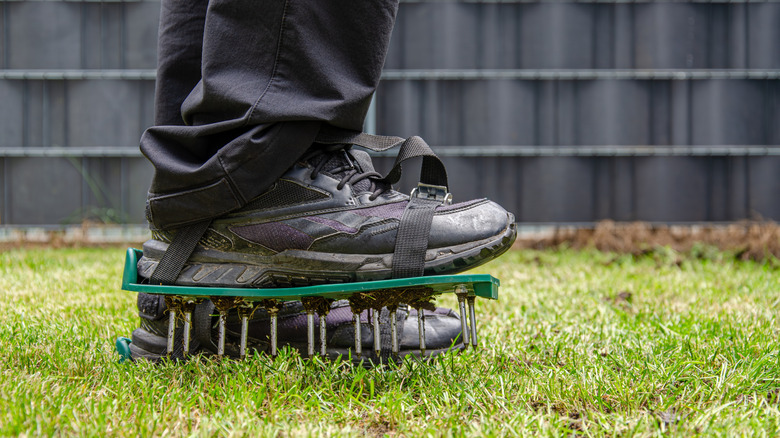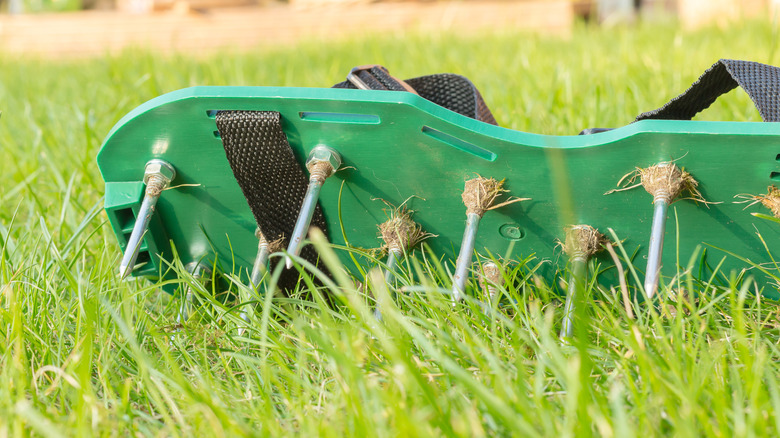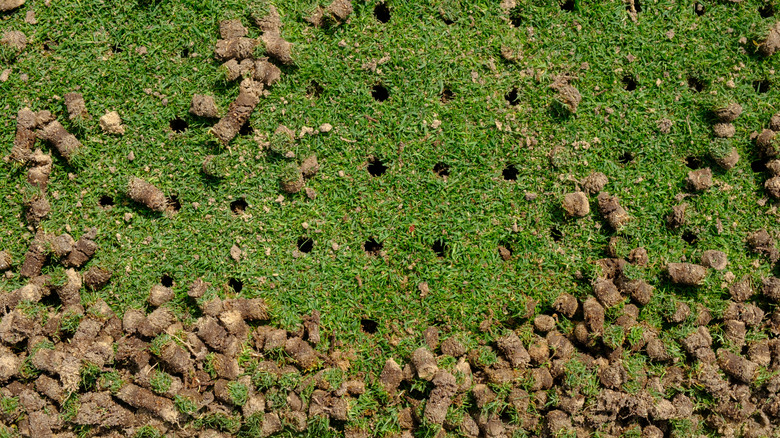Are Lawn Aerator Shoes Actually Worth It Or A Hoax?
Maintaining a healthy lawn is hard work, so it's understandable to look for easier, cheaper shortcuts when possible. But sometimes so-called "hacks" are way more trouble than they're worth. Lawn aerator shoes, which are supposed to reduce soil compaction while you walk on the grass, are a perfect example.
The soil in your lawn can become compacted over time due to frequent traffic, such as kids playing, pets running, or construction equipment. Soil compaction harms lawns in a number of ways, and some yards are especially prone to it (like those high in clay and silt). Aeration is the only effective way to reduce soil compaction, and depending on the state of your lawn, you should aerate anywhere from every six months to every five years. This process has the bonus benefit of reducing thatch buildup.
Lawn aerator shoes may seem like an enticing, budget-friendly way to aerate your lawn for less than the cost of a full-sized machine. With spikes on the bottom that dig into the soil with each step, they supposedly save time by allowing you to double-task while you mow the lawn. These spikes can be strapped onto any pair of footgear (some people also wear golf shoes as an alternative). Unfortunately, lawn aerator shoes aren't an effective method of reducing soil compaction. In fact, they can make things worse.
Why they don't work
It's not just lawn aerator shoes that are ineffective but aerators with solid spikes in general. These tines don't bring soil or thatch to the surface — a key step in reducing compaction. Even worse, soil gets pressed down between the spikes, which actually increases compaction. Aerators with solid tines are potentially suitable for regions with sandier loam, but those are less likely to be compacted in the first place. Instead, use an aerator with hollow tines, also known as a core aerator.
Even if you can find a lawn aerator shoe with hollow tines, there's another issue. Aerating the lawn by foot means only tackling a tiny percentage of the grass — the lawn directly under your shoes. You'd have to make a ton of passes back and forth or take the world's smallest steps to cover the whole yard. Also, it's impossible to adjust the depth of the tines on most lawn aerator shoes, which doesn't allow fine-tuning for different levels of compaction.
Lawn aerator shoes can also be a waste of money for homeowners with lawns that don't need aeration in the first place. Yards that don't get much foot traffic — such as those with separate walkways or properties without pets or kids — likely won't need to be aerated often, if at all. If you've already bought a pair of aerator shoes, it could be helpful to add some holes to your yard before planting or overseeding. But if you need to aerate your lawn for healthier grass, turn to a core aerator instead.
How to core aerate for best results
Core aerators are the best tools for reducing soil compaction in your lawn. They lift plugs of soil, or cores, out of the ground, which breaks up thatch and opens up the lawn's surface. If you're on a budget, renting an aerator for a couple of hours doesn't cost much more than you would pay for a pair of aerator shoes. Check nearby hardware stores and landscaping companies to see your available options. Core aerators are designed to be pushed, pulled, or driven across the lawn, somewhat similar to a lawn mower. For small areas of grass, you can also buy a handheld aerator.
How do you know if your lawn needs to be aerated? You can test whether the soil is compacted by trying to stick a screwdriver in when it's moist. If it's difficult or impossible, aeration is a good idea. The best time to aerate is when the soil is moist and the grass is actively growing. Avoid using a core aerator when it's hot and dry, as it may cause the grass to dry out too much and die. Water deeply a couple days beforehand if you really need to aerate in dry weather.
Allow the soil cores to dry out for two days, then mow or rake the lawn to help them break down more quickly. They will eventually filter back down into the soil, and if you do this process regularly, it can help smooth your lawn's surface as the soil from the cores fills in lower areas. Post-aeration is also a great time to add topdressing, such as compost, if needed.


